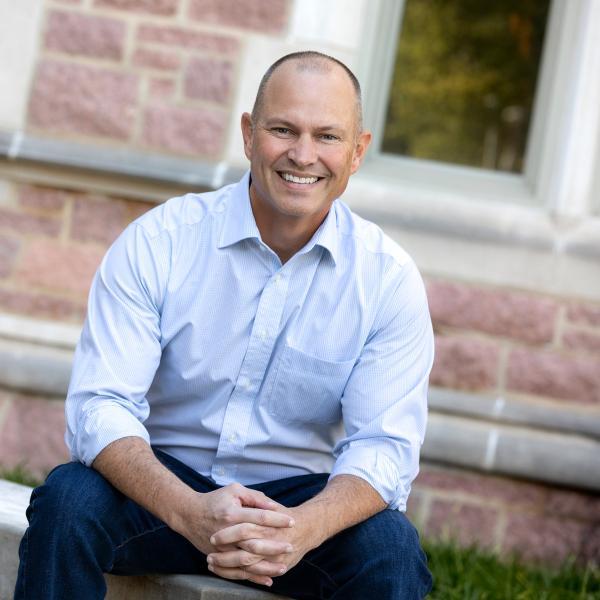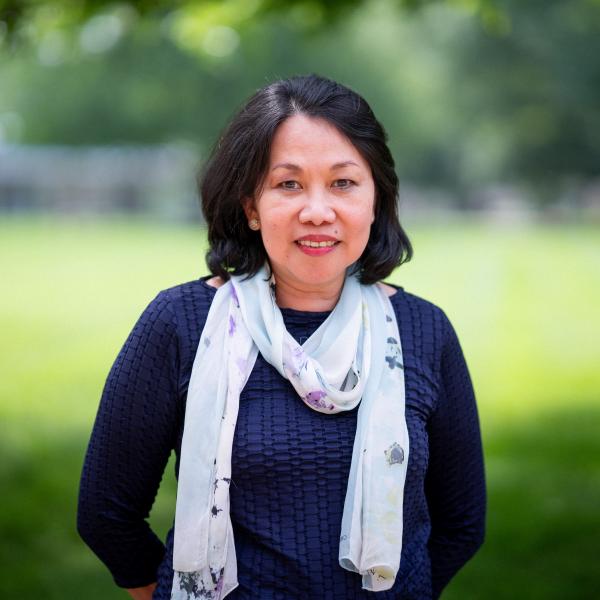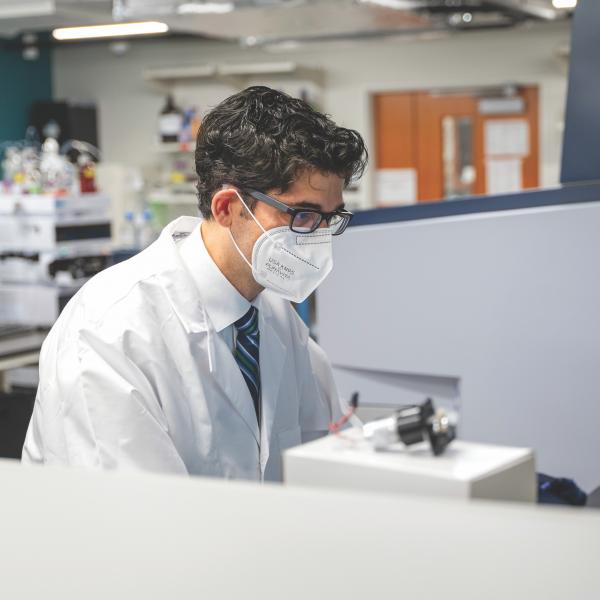The Chemistry Department Diversity, Equity, and Inclusion (DEI) committee celebrates Black History Month with a biographical series highlighting some of the most distinguished and influential Black scientists. These individuals were selected by members of the Chemistry DEI committee for their inspirational research, teaching, and leadership.
George C. Royal, Jr. and Gladys W. Royal
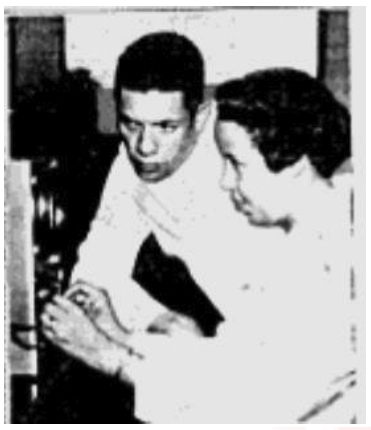
Drs. George C. Royal, Jr. and Gladys W. Royal performed important work in the field of radiation injury and treatment during the mid-20th century. George C. Royal, Jr. was a graduate of Tuskegee Institute, and he went on to earn an MS in microbiology from the University of Wisconsin and a PhD from the University of Pennsylvania.1 Gladys W. Royal completed her undergraduate work at Dillard University, her MS in organic chemistry at Tuskegee Institute, and her PhD in biochemistry at Ohio State University.1 While raising a family, both served on the faculty at North Carolina A&T College and worked collaboratively on a research project entitled “Biochemical and Immunological Comparisons of Irradiated Mice and Rats Treated with Bone Marrow Transplants.”1,2,3 The grant was funded by the U.S. Atomic Energy Commission and their work was shared internationally.2,3
The pair had several experimental goals, chief among them to characterize and “type” bone marrow (in a manner similar to blood typing) for decreased rejection of foreign marrow treatments.2 Timely work in the Cold War era and important for radiation-based cancer treatments, the Royals aimed to determine qualifications for donor marrow which could be given to treat recipients of high doses of radiation.2 As part of this work, they found that bone marrow from cows could be used in mice exposed to lethal doses of radiation.1 The pair were awarded multiple grants within this line of inquiry, totaling nearly $100,000.1 As a Black husband and wife team, rare in science at the time, the Royals presented their work at conferences including the Fifth International Congress on Nutrition in Washington, D.C. and the International Congress of Histochemistry and Cytochemistry in Paris, France, both in 1960. Their research informed some of our current understanding of bone marrow transplants.
After this work, Dr. George C. Royal, Jr. became the Dean of the Graduate School at North Carolina A&T College and then professor and chair of microbiology at Howard University. He and his colleagues studied bacteria and infections related to oral health, including oral candidiasis (also known as thrush).4,5 Dr. Gladys W. Royal pursued work in flavor chemistry in collaboration with Arthur S. Totten and by 1982 she had joined the U.S. Department of Agriculture to work on projects involving human nutrition.3,6 She was a supporter of undergraduate research programs and served as the president of the Beta Kappa Chi scientific society in the 1970s.3
References
- “A&T College Received Grant of $16,915 From U.S. Atomic Energy Commission To Continue Research Begun in 1958.” The A. & T. College Register, vol. 36, no. 3. 02 October 1964.
- “Husband-wife team’s project draws international interest.” The Afro American, 10 September 1960.
- Warren, Wini. Black Woman Chemists in the United States. Indiana University Press: 249-251. 1999.
- Royal Jr., G. C., Sampson, C. C., and Faggett, T. “A Rapid Passive Hemagglutination Method For Demonstrating Serum Antibodies to Candida Albicans.” J. Natl. Med. Assoc. 73 (12): 1135-1138. Dec 1981.
- Schlein, R. A., Kudlick, E. M., Reindorf, C. A., Gregory, J., and Royal Jr., G. C. “Toothbrushing and transient bacteremia in patients undergoing orthodontic treatment.” Am. J. Orthod. Dentofac. Orthop., 99 (5): 466-472. May 1991.
- “Team out to add flavor to chicken.” Washington Afro-American, 18 August 1964.
Squire Booker
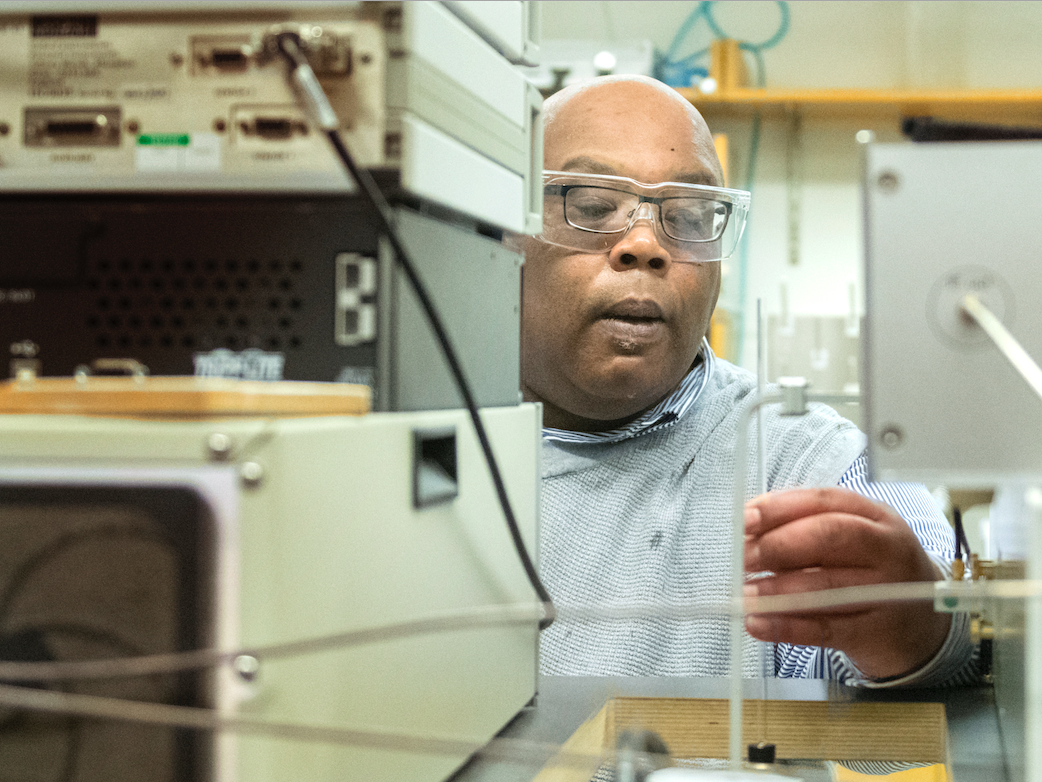
Dr. Squire Booker is the distinguished Evan Pugh University Professor of Chemistry and of Biochemistry and Molecular Biology at Penn State University.1,2 He is best known for his biochemistry research on electron transfer reactions mediated by Fe-S clusters found in the radical S-adenosylmethionine (SAM) family of enzymes that are involved in a variety of post-transcriptional modifications of DNA/RNA, posttranslational modifications of proteins, and the biosynthesis of structurally unique natural products.3,4 Research from Booker’s laboratory has clarified the chemical mechanisms used by radical SAM enzymes to harness the reactivity of carbon-based radical centers to achieve challenging regioselective and stereoselective transformations, mostly C-C bond forming reactions largely inaccessible to nature by any other means.5,6
Booker was born in Mexia, TX in 1965 and raised by his grandmother, Cleona Price, in Beaumont, TX.1 He graduated from Austin College with a BA in Chemistry and earned a PhD in Biochemistry at MIT with Prof. JoAnne Stubbe studying ribonucleotide reductase. After a brief time spent in Paris, France as an NSF-NATO postdoctoral fellow, he trained with Prof. Perry Frey in the Institute for Enzyme Research at UW-Madison studying the catalytic mechanism of lysine 2,3-aminomutase, a radical SAM enzyme. Booker joined the faculty at Penn State in 1999, initially in the Department of Biochemistry and Molecular Biology. He accepted a joint appointment in the Department of Chemistry in 2007 where he now leads a dynamic and collaborative team of enzymologists. He is a highly visible and active member of the American Chemical Society (ACS) and the American Society of Biochemistry and Molecular Biology (ASBMB) where he has served as Associate Editor for Biochemistry (ACS), Deputy Editor of ACS Bio & Med Chem Au, and Chair of the ASBMB Committee on Minority Affairs.1,2 He was selected as an HHMI investigator in 2015 and was elected to AAAS in 2017 and the National Academy of Sciences (NAS) in 2019.3 While NAS does not appear to publish data on the race and ethnicity of its members, it is noteworthy that only 4 members (Booker, Paula Hammond, Paul Turner, and David Williams) from Booker’s 2019 elected class (100 new members, 25 foreign associates) were Black scientists.7 In addition to being an accomplished independent academic scholar, Booker is actively paving a path of success, inspiration, and celebration for current and future generations of Black scientists to help improve the landscape of racial inequality in Chemistry and Biochemistry.2,8
References
- National Academy of Sciences: Squire J. Booker
- Wikipedia: Squire Booker
- https://science.psu.edu/chem/people/sjb14
- https://sites.psu.edu/sjbookerlab/
- https://www.science.org/doi/10.1126/science.1200877
- https://www.nature.com/articles/s41586-021-04392-4
- https://www.jbhe.com/2019/05/four-black-scholars-elected-to-the-national...
- https://www.nature.com/articles/s41557-020-00632-8
George Washington Carver
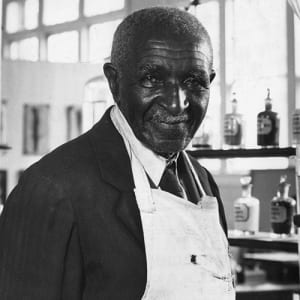
Born into slavery in Diamond, Missouri, George Washington Carver was kidnapped a week after his birth by raiders from Arkansas. He was sold in Kentucky but later brought back to Diamond, Missouri. During his early years, Carver was mostly home-schooled since no local schools were accepting Black students.1 As a young boy in search for more knowledge and a greater meaning, he attended a series of schools before earning his diploma at Minneapolis High School in Minneapolis, Kansas.
Carver was accepted to Highland College in Highland, Kansas, but was later denied admission when they found out that he was Black.1 Knowing that “knowledge is power” and with a desire for more of knowledge and higher academic laurels, Carver started conducting biological experiments at home. He even compiled a geological collection. Carver was relentless in his desire for more knowledge and eventually enrolled at Simpson College in Iowa to study art and music. While at Simpson College, he took greater interest in painting and drawing sketches of botanical samples, which led him to enroll in the botany program at Iowa State Agricultural College. Eventually, Carver was accepted to Iowa State University as the first Black student.1 He excelled in his studies and successfully completed his BS in botany. Carver went on to pursue a master’s degree in botany at Iowa State University. Through his graduate research, which included intensive work in plant pathology at the Iowa Experimental Station, Carver established his reputation as a brilliant botanist.
After obtaining his master’s degree, Carver was immediately hired by Booker T. Washington, the founder of the Tuskegee Institute, to run the agricultural department. As a researcher and an inventor, Carver devised more than 300 uses for the peanut, earning him the nickname, “The Peanut Man.”2 Under his leadership, the agricultural department received national prominence. He developed new crops and diversified the use of many crops. His inventions, which include groundbreaking research on the development of new uses for crops (peanuts, sweet potatoes, soybeans, and pecans), are well-documented.2 His development of new uses for crops helped to stabilize the livelihoods of many people. Carver pioneered a mobile classroom, the “Jesup wagon,” which brought lessons to farmers. With national prominence, Carver served as an advisor, on agricultural matters, to then-President Theodore Roosevelt.
Carver is famously known for saying, “It is not the style of clothes one wears, neither the kind of automotive one drives, nor the amount of money one has that counts. These mean nothing. It is simply service that measures success.”1 To that end, Mr. Carver was of great service to humanity in a multitude of ways. Thus, he was the first Black person to have a national monument, which still stands today at Tuskegee University, Alabama. Carver passed away in 1943 at the age of 78. His epitaph reads, “He could have added fortune to fame, but caring for neither, he found happiness and honor in being helpful to the world.”1
References
- Biography: George Washington Carver
- The Peanut Institute: The Incredible Accomplishments & Inventions of George Washington Carver
- HowStuffWorks: What Were George Washington Carver's Inventions?
Lisa M. Jones
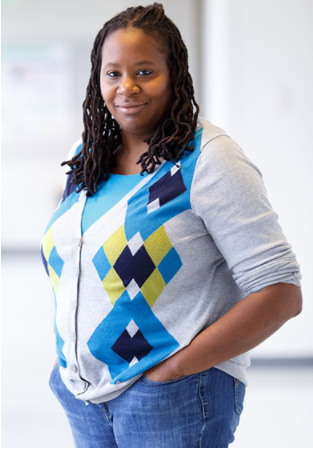
When Lisa M. Jones was a freshman in high school, she took part in a national Science Technology Engineering Program. Since then she has been interested in science. In 1999, she completed her BS in biochemistry at Syracuse University, which was followed by a PhD with a focus on structural biology at Georgia State University. After a postdoc in structural virology at the University of Alabama at Birmingham, she moved to Washington University in St. Louis where she worked with Dr. Michael Gross as a Pfizer Postdoc on mass spectrometry based protein foot-printing. She then joined Indiana University as an assistant professor before joining University of Maryland School of Pharmacy in 2016.1 Jones continues to work on protein footprinting and is particularly interested in fast photochemical oxidation of proteins (FPOP) to study protein interactions and conformational change of large protein systems such as virus capsids and antibodies.2
Besides her research, Jones is an advocate for diversity, equity, and inclusion. She said, “My goal is not only to teach students about research but also to provide them with information that I know from personal experience is generally lacking for underrepresented minorities in science.” Her NSF CAREER Award, which she received in 2016, also supported research training for undergrads from historically Black schools.3 Standing in solidarity with another Black women researcher, Nikole Hannah-Jones – a MacArthur Foundation “genius” grant winner studying on role of slavery and Black Americans in US history – who was denied tenure, Lisa Jones withdrew from being considered for a tenure-track position at University of North Carolina at Chapel Hill in June 2021.4
In order to increase diversity in STEM, Jones is involved in the UMB CURE Scholars programs at middle schools in predominantly Black neighborhoods. Her lab has about 22 students in the lab each year focusing on projects and diseases that are relevant to them and their communities, such as asthma and diabetes. Besides inspiring more diverse people to get into STEM, her efforts go towards keeping them there through continuous support through graduate school and eliminating workload imbalances arising e.g. from unrecognized committee work at the professor level.5 In January, 2022, Jones received an Initiative for Maximizing Student Development T32 training grant aimed at enhancing diversity in the biomedical workforce.6
On February 9, 2022, Lisa Jones announced on Twitter that her lab will be moving to UC San Diego this summer.7
References
- Wikipedia: Lisa Jones (scientist)
- https://faculty.rx.umaryland.edu/ljones/
- https://archive.news.iupui.edu/releases/2016/02/jones-nsf-career-award.s...
- https://cen.acs.org/education/Nikole-Hannah-Jones-tenure-dispute-causes-...
- https://theanalyticalscientist.com/business-education/how-can-we-grow-di...
- https://twitter.com/PharmSci_UMB/status/1484295356724744192
- https://twitter.com/LisaMJonesLab1
Marie Maynard Daly
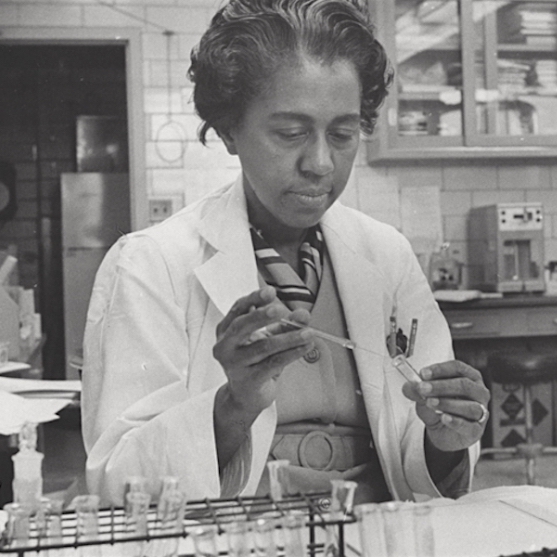
In 1947, Marie Maynard Daly became the first African American woman to receive a PhD in Chemistry in the United States. She conducted important studies on cholesterol, sugar, and proteins. In addition, she was committed to increase the enrollment of minority students in medical school and graduate programs.
Daly was born in 1927, in the Corona neighborhood of Queens in New York City, to a family of avid readers with a strong belief in the power of education. Daly’s father, Ivan C. Daly, was key in her decision to pursue a career in chemistry, as he was forced to drop out of Cornell University where he pursued a degree in chemistry due to financial circumstances. Marie Daly went on to obtain a bachelor’s degree in chemistry from Queens College in Flushing, New York, and a master’s degree from New York University.
In 1944, Daly enrolled at Columbia University where she worked under the direction of Mary Letitia Caldwell, PhD. Her research focused on how compounds produced in the body affect and participate in digestion. The title of her dissertation was “A Study of the Products Formed by the Action of Pancreatic Amylase on Corn Starch.” Daly is best known for her research on the effects of cholesterol, sugars, and other nutrients on the heart. Her research elucidated the relationship between high cholesterol and clogged arteries and increased our understanding of how foods and diet affect the health of the heart and circulatory system.
In 1960, Daly became a professor at the Albert Einstein College of Medicine, where she remained until her retirement in 1986. She dedicated much of her time to developing programs to get students of color enrolled in medical schools and graduate science programs. In 1988, Daly started a scholarship, in honor of her father, for minority students who want to study science at Queens College.
Learn more
- Charged Magazine: Hidden Figures: Let's Remember Dr. Marie Maynard Daly (video)
- Crystallize Podcast: Marie, Biochemistry, and Her Groundbreaking PhD (audio)
References

